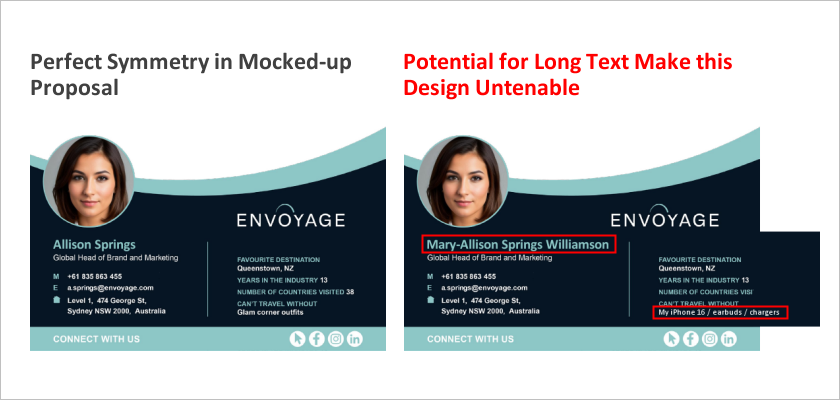Keep away from These Two Insurmountable E-mail Signature Design Errors

As a designer, level-setting expectations are of crucial significance in the event you want to keep away from the uncomfortable state of affairs of making an exquisite e-mail signature design, solely to find later that it’s continuously failing within the, all the time messy, realm of e-mail. Step one on this course of is to take sure design ideas off the desk earlier than they ever see the sunshine of day. This text will give attention to two such design ideas – ones which might be certain to trigger unresolvable aggravation if pursued…
Compromise is nearly all the time the important thing to efficient e-mail signature design. Why? As a result of the medium is just not standardized and varies broadly in its means to render the specified consequence. As an analogy, think about designing a print advert, however throw in a twist – your advert might be printed on:
- Premium machine-finished coated (MFC) paper
- Newsprint
- Cardboard
Instantly you possibly can see that the attractive paintings, vibrant colours, and small textual content that you just’d love to make use of (and will for MFC paper), isn’t going to translate so effectively onto newsprint or cardboard. Your choices are clear:
- Make it seem nice in a single case, however poor within the different two.
- Compromise on the design in order that it’s fairly good in all three.
That is, sadly, what we’re caught inside the world of e-mail signatures. Quite than MFC, newsprint and cardboard, we’re caught with:
- Pc display screen vs. cell phone display screen
- Normal view vs. darkish mode
- HD / Retina Show vs. customary decision
- Outlook desktop vs. Outlook Internet vs. Gmail vs. all different e-mail applications
- iPhone vs. Android
- Picture blocking turned on vs. picture blocking turned off
- And many others.
These will be mixed in an nearly infinite variety of mixtures, making the compromise resolution difficult. Incessantly this ends in forsaking your most visually interesting designs, opting somewhat for extra “work-a-day” design ideas. Unhappy as this can be, it’s crucial if you’re to create a practical e-mail signature that survives the somewhat crude surroundings it is going to exist in.
As a designer, level-setting expectations with your self, and along with your shopper, is of crucial significance in the event you want to keep away from the uncomfortable state of affairs of making an exquisite e-mail signature design and dealing via the implementation course of, solely to find that it’s continuously failing in, all the time messy, realm of e-mail. Step one on this course of is to take sure design ideas off the desk earlier than they ever see the sunshine of day.
This text will give attention to two such design ideas – ones which might be certain to trigger unresolvable aggravation if pursued.
Design Mistake #1: The Left / Proper Alignment Entice
It’s an plain facet of e-mail rendering – spacing between traces of textual content is not going to be constant from one e-mail program to a different. With any multi-column design, this can manifest as both a barely poor consequence or as a really poor consequence, relying in your preliminary design idea.
Right here’s an instance of a two-column design that appears good when rendered correctly, however breaks badly when the right-hand column (the textual content portion of this signature) expands vertically:
The visually evident separation illustrated above is definite to draw the shopper’s consideration and can doubtless require the full remodeling of the design itself (as the issue proven can’t be mounted).
Be smart and keep away from this downside upfront by introducing the shopper to a revised design idea that’s considerably much less visually interesting, however way more strong. The next graphic illustrates a remodeling of this design the place the vertical enlargement of the right-hand column is just not simply perceptible to the informal observer (the signature fails gracefully).

Whereas the shopper might discover the dearth of consistency in rendering, they’re more likely to settle for the reason of variance between e-mail shopper applications, and unlikely to view the issue as important sufficient to require the whole remodeling of the signature.
Design Mistake #2: Designing to a Symmetrical Form
When making a mock-up or proof to current to the shopper, it’s human nature to place your finest foot ahead. This may shortly result in deceptive outcomes.
Within the case of symmetry, there are two major issues:
- The identical inconsistencies in vertical spacing are mentioned above
- Failure to contemplate the potential for exceptionally lengthy strings of textual content
Right here’s a very good instance of a design mockup that regarded nice, however sadly couldn’t work correctly in observe:

On this case, it’s the center desk row of the signature that’s increasing – horizontally somewhat than vertically (though vertical enlargement would happen as effectively, it’s simply not illustrated right here). Open-ended knowledge fields are topic to longer strings of textual content which might be usually anticipated and may wreak havoc with designs if not deliberate for in the course of the design section.
Degree-Setting Expectations
Quite a lot of angst will be averted by by no means exhibiting the shopper a design that has both of those elementary flaws in its structure. As soon as the shopper has seen your stunning design, it is going to be caught of their head and the compromised design that you just finally have to offer (to make the signature truly work) will thus be disappointing.
If you’re not sure whether or not a design is technically possible, ask an professional – somebody who understands the ins and outs of e-mail signature programming can determine any elementary flaws in seconds, saving you a substantial amount of time, effort, frustration, and disappointment down the street.
Remaining Ideas: A Conceptual Framework for Pondering About Layouts
Whereas it’s a bit tough to concisely articulate a tenet for design, the one phrase that involves thoughts is “free”. An analogy may match higher…
Take into account a room, adorned with sq. and rectangular furnishings, rugs and work, every part organized “simply so”. Now think about twisting and turning every part barely, only a few levels. The room will instantly look terribly messed as much as nearly any observer. Conversely, think about a room adorned with organically formed furnishings (suppose bean-bag chairs), oval rugs and freestanding sculptures. Now twist and switch every part a number of levels. It’s unlikely that anybody would even discover the distinction. That is how e-mail signatures ought to be designed – free and permitting for small actions of their parts.
To perform this, keep away from the temptation to make use of coloured backgrounds and/or borders for e-mail signatures. The “framing” impact that these present creates an expectation of placement, whereas their absence creates no expectations in any respect. Particular person parts – logos, sections of textual content, icons, and so forth. – “floating” on a white background (or black for darkish mode) can transfer round barely relative to 1 one other with out visually upsetting the design. Delivering an e-mail signature that fails gracefully will result in a buyer who’s happy over time, versus a buyer who has no finish of complaints about how the signature is working (with a number of the issues, equivalent to the 2 highlighted on this article, being unfixable).
Should you’re not assured in your means to design and code an e-mail signature that can stand up to the pains that await it, utilizing an e-mail signature service like Dynasend is a straightforward means to make sure that the deliverable might be strong and trouble-free. The Digital Company Community’s E-mail Advertising Weblog can also be a fantastic useful resource for locating tips about tips on how to maximize the effectiveness of your e-mail signature program.
Learn the complete article right here







